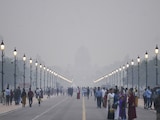Nestled amongst the hills of Kullu in Naggar is a gravestone with these words on it: "Here on December 15, 1947, the body of Maharishi Nicholas Roerich - a great Russian friend of India - was committed to fire. Let there be peace."
There are few instances when the simplest of words convey such meaning. Nicholas Roerich, who was born on this day 150 years ago, was, first and foremost, an Indophile, someone who perhaps can be said to have laid the foundation of Indo-Russian friendship. But, to know Roerich and his work - whether on canvas or paper - one has to encounter India.
Roerich's Time At Ishwara
Roerich was a painter, traveller, writer, philosopher, and, as many in his native country consider, a mystic. His extraordinary life is the stuff books and films are made of, but with a touch of the sublime and mystical. Roerich's abiding love for mountains was partly instrumental in his engagement with India and why he later made Naggar his home. Early in life, his family spent time at an estate near St. Petersburg named "Ishwara". The previous owner had hung a picture on the wall of what Roerich later realised was Kanchenjunga. As a child, he loved looking at it. Later, it was his wife Elena who introduced him to Indian thought, especially Buddhism, to which she had been introduced by Elena Blavatskaya, one of the founders of the Theosophical Society. Blavtaskaya had been to India and had converted to Buddhism.
Solveig's Song (1912) by Nicholas Roerich
Photo Credit: Wikimedia Commons
When Roerichs Met Tagore
Hailing from an upper-middle-class family, Roerich grew up in a milieu where his family often entertained the city's cultural elites. It was also a time when, fatigued by constant conflict and wars, the Western world was increasingly looking towards the East for spiritual succour to "reorient" itself. At the beginning of the 20th century, Roerich's native Russia plunged into revolution and civil war. Recuperating in Finland when the Bolshevik Revolution gripped Russia, the Roerichs travelled to Europe, never to return. In England, they met Rabindranath Tagore and were greatly influenced by him. They then travelled to the US, where, already engaging with Indian philosophical traditions, they established the Agni Yoga Society in New York and an art institute. As we understand now, the society had less to do with yoga and was more focused on promoting religious harmony and the brotherhood of nations; the art institute went on to become the Nicholas Roerich Museum in 1949.
From the US, they finally landed in India in 1923. They toured India extensively, interacted with its cultural and political elites and civilians, and studied its ancient culture, traditions and religions, all of which found expression in Roerich's paintings and writings. It was from India that Roerich embarked on his famed Central Asian expedition from 1923-1928 through Sikkim, Tibet, Kashmir, Ladakh, Siberia, Altai and Mongolia. But the mountains kept beckoning to him and he finally settled down in Naggar in Kullu. There, he founded the Urusvati Himalayan Research Institute in 1928.
The Love For Himalayas
Of the 7,000-odd paintings that he left behind, at least 2,000 are dedicated to the Himalayas, which for Roerich symbolised man's spiritual longing and spiritual transcendence. This is how he described the Himalayas: ".....Here was the Abode of Rishis. Here resounded the sacred Flute of Krishna. Here thundered the Blessed Gautama. Here originated all the Vedas. Here lived Pandavas. Here was Gessar Khan. Here was Aryavarta. Here is Shambala. The Himalayas are the Jewel of India. The Himalayas are the Treasure of the World. The Himalayas are the sacred symbol of Ascent."
Much later, Roerich was declared a National Treasure Artist of India, along with other eight masters like Tagore, Jamini Roy, etc.
Roerich's car in Naggar
Photo Credit: Wikimedia Commons
Similarly, many of Roerich's writings have an Indian theme. He was greatly influenced by the Hindu concept of the cyclical nature of time, as also by old Slavonic spirituality and Russian Orthodoxy. He tried to promote a synthesis of Indian and Russian spirituality. Many of his writings depict the struggle between the shadow and light, with the latter always emerging triumphant - a search for the pristine "Shambala".
Dhammapada In An Atheist State
Roerich was not alone in his endeavour to acquaint Russia, or the world for that matter, with Indian spirituality. Along with his wife, his sons also made their individual contributions to furthering Indo-Russian friendship and understanding. The elder son, George (Yuri) can be credited with promoting Indology in the Soviet Union. In 1957, he went to the then-USSR and lived there for three years, before his tragic untimely death. Russian Indologists consider him and his contribution a key to the second flowering of Buddhist and Indian studies in the Soviet Union; the first occurred during the Tsarist period. He was a scholar who championed the publication of the Russian translation of the Dhammapada [Buddhist holy text] by Vladimir Toporov. This was unheard of then. And given that the state then officially denounced religion, this was a revolutionary step. Later, the writings of both Roerich and Elena helped spread Indian mysticism in the Soviet Union and later in the Russian Federation, with a number of Roerich Societies springing up in different parts of the country.
Shelkar Dzong (1928), by Nicholas Roerich
Photo Credit: Wikimedia Commons
The younger son, Svetoslav, often more famous as the husband of Devika Rani, the First Lady of Indian cinema, also did his bit through his numerous paintings. He remained in India all his life.
There's another legacy Roerich has left behind: the Roerich Pact, or the Treaty on the Protection of Artistic and Scientific Institutions and Historic Monuments. An international legal document, the pact is aimed at ensuring the unconditional protection of cultural property. The pact has never been more significant than today as the world witnesses the wilful destruction of ancient and cultural heritage in places like Afghanistan, Iraq, Syria, and Gaza.
There Is No Future Without The Past
For Roerich, knowledge and beauty epitomised life itself. This sentiment is beautifully portrayed in his drama Mercy ('Miloserdiye') which this writer has been privileged to have translated from Russian to English.
Roerich passed away on December 15, 1947. In keeping with indic tradition, Nicholas, his wife and later son Svetoslav, were all cremated and samadhis erected over their ashes. His demise put an end to the work of the Urusvati Centre; it is now a museum of the International Roerich Memorial Trust, which houses a number of paintings by both Roerich and son Svetoslav. Yet, his rich legacy remains almost obscure in India, restricted to niche circles. This Russian friend of India deserves far more. As Roerich said: there is no future without the past.
(Aditi Bhaduri is a journalist and political analyst. She has translated the works of Nicholas Roerich from Russian to English)
Disclaimer: These are the personal opinions of the author















